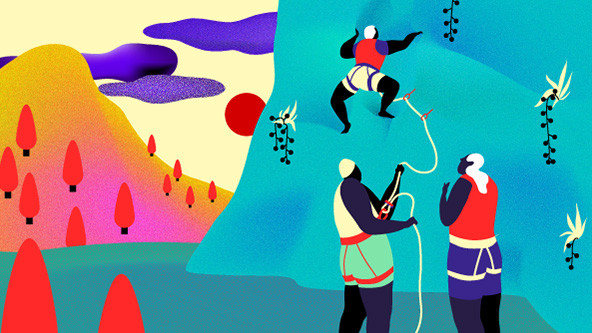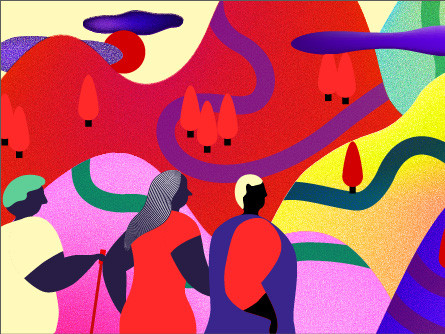 (Illustration by Ailadi)
(Illustration by Ailadi)
Most large organizations operate under strict rules and policies designed to maximize efficiency, not innovation. The humanitarian sector is no exception, and skeptics often ask us why innovation is worth fighting for given the scale of challenges and lack of resources at hand. Yet this is precisely why innovation is relevant to our work. It’s a tool that brings us to the heart of people’s needs. It makes our assistance more relevant and resourceful.
At the United Nations High Commissioner for Refugees (UNHCR), this mindset has helped us understand how to build an organizational culture across 130 countries that incentivizes and rewards innovative thinking. Yet the challenge remains: How do we build an organizational culture that embraces innovation but remains governed by traditional rules?

Use Internal Structures to Support Innovation
Social norms—the unwritten guidelines that dictate which behaviors society considers appropriate and inappropriate—profoundly shape how we behave. We follow norms without realizing we’re doing so, largely because they spare us the discomfort of predicting each other’s behavior. In humanitarian settings, written guidelines like the ones in the Sphere Handbook help us improve the quality of our work during crises, while unwritten rules help us coordinate with each other on an unprecedented scale. We wouldn’t show up at one of our local partners’ offices unannounced, for example. It’s a simple folkway, but combined with many others, it helps organize our interactions. Rules also frame each step to accomplishing a goal—whether procurement, partnership agreements, or contracts—ensuring that the processes that drive our organizations are transparent and trackable.
Innovation in the humanitarian context, then, may seem like a mismatch. Yet the work we have undertaken to advance innovation in our respective organizations has led us to an unlikely conclusion: Adhering to and mastering the rules is a vital precursor to innovation. The reason for this is twofold. First, successful innovation requires some adherence to rules, since they support the translation of creative ideas into something organizations can implement. Second, obtaining support from gatekeepers and end-users is contingent on securing their trust, and innovators can only gain that trust if they understand existing rules before proposing new approaches and behaviors.
Consider UNHCR’s Innovation Fund, which supports talented, cross-functional teams in the early stages of product, service, or process development to test their solutions, with a view to building an evidence base that UNHCR can leverage to secure additional resources. To enable teams to test their solutions effectively and responsibly, the fund requires that teams sign a terms-of-use agreement, which outlines a handful of milestones to guide the implementation of projects. Examples of milestones include the completion of a value proposition and establishing feedback loops with users. In addition to providing some structure to implementing a diverse set of projects, the milestones are built to accommodate UNHCR procurement and program deadlines to ensure that teams can realistically implement their innovation projects within the organization. Since the release of funds is contingent on meeting milestones, teams are incentivized to adhere to rules as a way to build alliances with gatekeepers and ensure that their projects have a realistic chance at succeeding in a large organization like UNHCR.
Learning and mastering the rules also gives organizations the opportunity to pinpoint areas within the organizational culture and institution where innovation can thrive and create real change. In procurement, for example, a plethora of regulations exist to ensure that the process of purchasing goods is fair and competitive. While these rules work well enough to procure jerry cans and tents, the changing nature of humanitarian response has demanded that we increasingly purchase digital products and services. By navigating the regulations over the years, we identified both flexibilities that support the procurement of digital services (such as setting up smaller contracts to test services before scaling) and barriers that hinder the acquisition of effective products and services to support an innovation process (such as the need to outline detailed specifications for bespoke digital services before tendering). The latter presented the risk of locking technical requirements into a tender, leaving little room for us to deploy other, potentially more advanced technologies in the solution. We are now testing an approach to leverage outcome-based specifications in tenders, which describe the end performance we expect from a digital solution, rather than being very prescriptive about specifications. This approach complements the innovation process well, since it lends more flexibility to the development process.
Ultimately, innovators don’t always have to break the rules to drive a more creative and responsive culture; they can bend and mold them to create new opportunities.
Build an Environment That Supports the Norms You Want to See
There’s no universal innovation culture, and organizations can’t copy and paste another organization’s culture into their own. However, there are fundamental values and observable skills related to innovation—including diversity of thought, curiosity, and trust—to guide organizations. For example, observable and obvious expressions of trust are a trial-and-error approach to work, some level of risk-taking, and being open to unexpected consequences.
A bigger question might be how to introduce new behaviors within a large and complex organization. The list of barriers to introducing innovative behaviors into humanitarian organizations is long and likely similar to any other large organization. Innovation is often misunderstood to equal technology and “cutting-edge solutions,” rather than a process that requires a change of individual and collective behavior. The experimental and iterative nature of innovation requires that we work in a very different way than we are used to, and accepting uncertainty as an inevitable part of innovation can be uncomfortable and cause fear. Creating safe spaces for the development of innovative behaviors and using influencers to model them are two ways organizations can start introducing new norms they want to see.
UNHCR’s Innovation Fellowship program, for example, prepares participants to become innovation change agents within UNHCR by building their innovation skills and competencies and supporting them to facilitate innovation with colleagues, partners, and refugees. The fellowship is a sort of micro-cosmos within an existing organizational culture—a safe environment to introduce, recognize, and reward new behaviors UNHCR wants to see in the fellows and eventually across the organization. For example, the program promotes collaboration by requiring that fellows work with each other. It also incentivizes fellows to exhibit behaviors through gamification; the colleague who helps the most number of other fellows in the cohort, for instance, may “win” a trip to collaborate with another fellow in the region.
Once the fellows begin emulating behaviors such as moving at a quick pace (action-oriented innovation) and experimentation within the fellowship community, we expect them to introduce these behaviors into their teams and country operations. In this sense, they are “innovation ambassadors,” or intrapreneurs, who demonstrate how innovation works to other UNHCR staff, take part in the development of new initiatives, and prompt others to become innovators and collaborators. In 2016, for example, one fellow’s work and commitment inspired several colleagues in his operation in Assosa, Ethiopia, to apply to the fellowship program. UNHCR selected one in 2018 and another in 2019. The fellows collaborated on additional projects and, together with colleagues in their teams, developed a concrete action plan to make innovation and collaboration an integral part of their day-to-day work in Ethiopia. This included the creation of a working group made up of UNHCR staff and partners focused on creating opportunities to sharing new ideas.
Harness New Norms to Structure Innovation
As organizations begin building an environment for new norms, it’s important to identify where new behaviors will be most effective and to think about their secondary effects. Finding ways to translate new norms into a culture that supports new ways of working is the next frontier. More importantly, organizations must find the leverage points where innovation creates the most value.
One example of an innovation culture’s add-on effects is UNHCR’s unique engagement with the Joint IDP Profiling Service (JIPS). JIPS is an interagency technical service, co-hosted by UNHCR and the Danish Refugee Council, that helps government, humanitarian, and development partners improve and agree on evidence related to people displaced inside their country’s borders. Since 2014, UNHCR has hosted four innovation fellows from JIPS to help them reimagine their own culture. JIPS’ work requires that team members both master the rules and balance the technical rigor of evidence-building with collaboration and positive dialogue among partners. JIPS also strives to strengthen the role of displacement-affected populations in data collection and analysis, and the fellowship provided JIPS team members with the safe space and tools to better test and implement user-centered approaches.
Building on an innovation project produced during the JIPS-UNHCR innovation partnership, JIPS began experimenting with how to better mainstream and facilitate community engagement in data processes. Through this project, JIPS helped displaced populations in Myanmar lead the decision-making process for better communicating and disseminating data within their own communities. Based on this precedent, JIPS continued expanding and mainstreaming community engagement in its day-to-day work and organizational culture, and across projects in different countries. In Thessaloniki, Greece, for example, refugee and asylum seekers played an active role in developing frameworks for measuring local integration.
This work culminated in the creation of a set of six principles that helps JIPS engage displaced communities more systematically and effectively as they take an active role in the production, analysis, and validation of data based on their own priorities and realities. JIPS now promotes these principles internally, as well as globally and among its partners, and has continued applying them in different contexts, including in Sudan and in Honduras.
Innovation Is About People
Innovation doesn’t happen without innovators. Through becoming a virtuoso of rules and harnessing observable skills and expressions, such as empathy and a drive to learn, each person can contribute to a culture that supports innovation. Our experience supporting programs like the Innovation Fellowship and Innovation Fund is that innovators can come from any part of the organization. They aren’t bound to a certain age, nationality, position, or gender. Rather, they’re equipped with the right attitude, a creative mindset, and an ability to see things differently and bend the boundaries of an organization. Most importantly, they have a desire to solve complex challenges, and given the right tools and environment, each person has the power to create change.
Many people work in organizations that, on their surface, may appear too bureaucratic or regulated to foster innovation. But by first understanding internal systems—including policies, rules, and administrative processes—people can find ways to use them in support of innovation, as well as pinpoint areas that would most benefit from innovation. From there, by creating environments that enable the development and spread of new behaviors, organizations can build a culture that supports innovation.
Support SSIR’s coverage of cross-sector solutions to global challenges.
Help us further the reach of innovative ideas. Donate today.
Read more stories by Emilia Saarelainen, Dina Zyadeh & Isis Núñez Ferrera.

